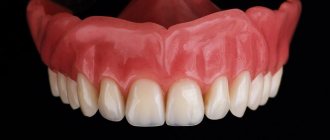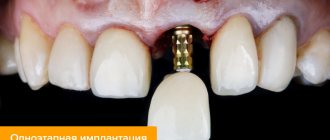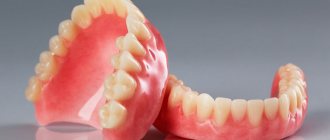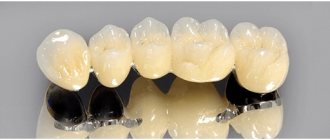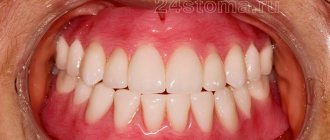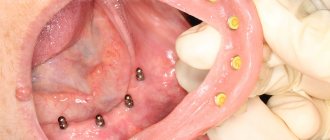The use of metal-ceramic crowns in the prosthetic procedure makes it possible to restore the natural anatomical configuration of a damaged tooth, its functionality, and also its aesthetic appearance. The price of metal-ceramic crowns is quite affordable and therefore this prosthetic option is incredibly popular among most patients in dental clinics.
In the article we will talk in detail about the process of installing metal-ceramic crowns on a tooth: we will consider the types of structures, indications and contraindications for their use, and also find out how much a metal-ceramic crown costs at Vanstom Dentistry in Moscow.
Metal-ceramic crown: design features
An orthopedic prosthesis made of metal-ceramics is a special onlay that is worn during the prosthetic procedure on a tooth that has previously been subjected to the grinding process. The shape of the metal-ceramic crown is identical to the anatomical configuration of natural teeth and repeats it down to the grooves on the tooth surface.
If you look at the photo of the metal-ceramic crown that we posted below, you will see that the base for creating the structure is a solid metal frame and the thickness of its walls can reach 0.5 millimeters. The contours of the frame are similar to the contours of the “native” tooth. On top, the frame base is covered with a layer of ceramics, which matches the color of the natural enamel coating.
Fixation of metal-ceramic crowns is carried out by fixing them on the prepared tooth using a special cementing composition.
Is there an alternative to metal ceramics?
It is not difficult to replace metal-ceramic crowns; the most difficult thing will be the choice between the desire for a beautiful smile and the desire to save money. When making a decision, consider where exactly in the dentition the organs that require restoration are located:
- Frontal teeth. Here it is better to prefer aesthetics and opt for metal-free prostheses made of zirconium dioxide or porcelain crowns. In addition, the chewing load on these teeth is minimal. And in any case, you will have to say goodbye to the bad habits of biting threads and gnawing seeds.
- Chewing teeth . Functionality and reliability are more important here. You can install an all-metal crown, which will give odds to even metal-ceramics in terms of strength, durability and gentle pre-treatment of the tooth before prosthetics. The main thing is to make sure that such a crown will not shine from the depths of the mouth when talking and smiling, because this is unacceptable, for example, for public people or those occupying high positions.
- Combination of teeth . Let's say a patient needs to install a bridge between the fourth and sixth teeth. The number four is exposed when you smile, and this tooth attachment is made of metal ceramics, while the other units are solid cast metal. In addition, less teeth are prepared for metal structures, which means the bridge will last longer. Let’s assume an option that combines metal-free and metal-ceramic units. This will reduce the cost of the design without compromising the aesthetics.
Materials for the manufacture of metal-ceramic crowns
Metal alloys
To produce the frame of a metal-ceramic crown in modern dentistry, three types of alloys from different metals are used:
1. Alloys of cobalt and chromium, nickel and chromium. The cost of a metal-ceramic crown made from these alloys will be as low as possible, but it is worth knowing that the listed metals often cause allergic reactions and irritation of gum tissue, and therefore the savings obtained when installing them are questionable.
2. Alloys of palladium, platinum and gold. This material for the production of prosthetics has a number of advantages: hypoallergenic, the ability to create the most natural tone of the prosthetic structure, which is especially important in the process of restoring teeth included in the smile line.
Another type of alloy that is used in the production of metal-ceramic crowns is a mixture with titanium as a base. Titanium alloys are not capable of causing allergic reactions; when used, the risks of rejection and incompatibility of the prosthesis with the tissues of the oral cavity are minimal.
Metal-ceramic crowns
from 8000 rub. More about prices
We have been working since 1994
we are one of the first to open private dentistry in Moscow
Best materials
only new and modern equipment for dental treatment
Free
consultation with a dentist
Payment options
- cash
- plastic cards
- cashless payments
Doctors' experience
- with great experience
- graduated
- conference participants
What is better: a zirconium crown for a tooth or a metal-ceramic crown?
Zirconium compares favorably
aesthetic properties - it is white. The absolute biocompatibility of the material is also attractive - zirconium does not cause allergic reactions.
But the cost
Such prosthetics are more expensive than metal-ceramics (
from 27,900 rubles per tooth
), especially if it is necessary to restore several molars. Such dentures are installed on chewing teeth for people with allergies. Preference is given to porcelain-coated material when restoring front row units.
Metal-ceramic crowns before and after photos of our patients
Photo before
Photo after
Pros and cons of metal-ceramic prostheses
Advantages
- Durability - withstands high chewing loads;
- aesthetics - the color of the ceramic cladding is identical to natural enamel;
- Manufacturing of the prosthetic system takes 7-14 days;
- hygiene - metal ceramics do not accumulate bacterial plaque;
- ease of care;
- low price.
Flaws
- Volumetric preparation of supporting units, depulpation is required;
- some metals can cause allergies and oxidize upon contact with saliva (the exception is a frame made of precious metals);
- can injure the enamel of opposite, neighboring units;
- when the gums recede, the frame may become visible through the ceramic layer (a dark stripe at the gingival margin);
- Not recommended for installation on anterior teeth due to the “gray neck” effect.
Ceramic coating
The metal frame of the orthopedic structure is covered with a layer of dental ceramics, which in composition is almost similar to household ceramics, however, the compositions for lining metal-ceramic crowns contain an increased content of components such as albite and orthoclase, which increase the strength of the created layer.
The ceramics are applied to the frame in layers and specialists use a special tool for this work. After applying the next layer, the structure is fired in a vacuum oven. This is necessary to ensure the strongest possible adhesion of the ceramic layer to the frame.
Reviews of metal-ceramic crowns from patients indicate that this type of dental orthopedic structures is not only strong and durable, but also highly aesthetic, which makes it possible to regain an attractive and natural smile!
Installation of an implant on 1 tooth
A dental implant is a screw that is used as an artificial replacement for natural tooth roots. This screw or artificial root is made from materials that are biocompatible with the human body, such as titanium. The implant can be used by the patient for decades in the upper or lower jaw. Once bonded to the jawbone and gum tissue, the implant provides a stable foundation for artificial teeth such as dental crowns, bridges and dentures.
You can read more about implants and their prices in our services section – implant installation.
Indications and contraindications for the installation of metal-ceramic crowns
Installation of a metal-ceramic crown is indicated in the following circumstances:
1. If there is a need to reconstruct damaged teeth to restore full chewing function and aesthetic appearance.
2. Metal-ceramic crowns are indicated for installation in case of abnormal position of teeth in a row, to eliminate a number of aesthetic defects: discoloration of natural enamel, severe chips.
Like any other medical procedure, prosthetics with metal-ceramic structures also has a number of limitations:
1. Metal-ceramic crowns cannot be installed if you are allergic to metal alloys.
2. You should refrain from the procedure if you have weak and painful gums, periodontal diseases, or malocclusion.
Metal-ceramic crowns are not placed on young patients under 16 years of age.
How to install a crown
Installation of crowns on metal-ceramic teeth begins with a general examination: the doctor prescribes preparatory treatment procedures, if any are needed.
Preparing your teeth
– this is a careful gentle grinding, in difficult cases – removal of the nerve. If the condition of the molars does not require pulp preparation, then they are left “alive”.
Impressions are taken, from which crowns will be made that completely replicate the shape of the natural tooth. An enamel color close to natural is selected.
The installation process takes from a week to two, taking into account the individual characteristics of the patient, the need for additional preparatory procedures for sanitation, professional cleaning and other nuances.
The process of installing metal-ceramic crowns
The main task of a specialist in prosthetics using metal-ceramic crowns is the accurate reconstruction of the root part of the tooth and its crown part. This is essential for completely restoring the functionality of the tooth.
In the restoration of the root part of the tooth, the following can be used:
- Stump inlays. Their use is advisable when the tooth root is healthy and does not have significant damage;
- Dental implant in cases of lost root part.
The prosthetics process takes place in two main stages, which are worth talking about in more detail.
Installation feature
During the process of prosthetics, the dentist follows a predetermined sequence of actions. The installation consists of several stages:
- Therapeutic stage. Initially, a diagnosis of the condition of the oral cavity is carried out. The doctor takes a picture and checks the condition of the canal. If necessary, treatment is carried out. If the crown is severely damaged, it may be necessary to install a special stump inlay.
- Tooth preparation. The dentist fills the root canals and grinds down the enamel. This process is carefully controlled so as not to remove excess. Next, a silicone mass is taken and an impression is made with its help. Based on this impression, it will be possible to create a finished crown on a metal frame and try it on so that your new tooth does not differ in appearance from the others in the row.
- Installation. Initially, the dentist uses the composition for temporary fixation. This is important so that a person can understand whether everything is fine with the crown, whether it is comfortable to chew and clench the jaw. If no complaints appear, then instead of a temporary composition, a permanent one is applied.
Free consultation on the cost of treatment in our dentistry
Leave a request and the clinic administrator will contact you within 15 minutes!
Preparatory stage:
1. The patient comes for examination to a specialist. After assessing the condition of the tooth and a series of studies, the dentist makes a decision on the prosthetic technique.
2. If the root part of the tooth is alive, then it is possible to carry out a series of therapeutic manipulations, during which the specialist eliminates all inflammatory and destructive processes, if necessary, the dental canals are re-filled and a pin is applied.
If the tooth root is significantly weakened, then the pin cannot be used, and in this case, before installing a metal-ceramic crown, the specialist uses a stump spacer, designed to replace bone tissue that has undergone the process of destruction.
3. If the root of a tooth is missing or severely damaged, a dental implant must be installed. A metal-ceramic crown on an implant will cost more than other options, but this type of prosthesis has maximum durability and strength and is visually indistinguishable from natural teeth.
After all clinical training activities are completed, the second stage of prosthetics begins - laboratory.
Laboratory stage of installation of metal-ceramic crowns:
During the laboratory stage of prosthetics with metal-ceramic crowns, the structure itself is manufactured. The process consists of the following stages:
- Taking impressions of the patient’s teeth;
- Modeling of the structure frame;
- Trying on the finished prosthesis;
- Correction of possible defects.
The process ends with the installation and fixation of a metal-ceramic crown.
Differences between metal-ceramics and other materials
This orthopedic design has gone through a long path of development and change before becoming what we see it today. Among dentists, this type of product is considered one of the most functional and aesthetic.
The issue of biocompatibility also fades into the background - many installation technologies do not require implantation into the bone tissue of the base gum.
Traditional alternatives are zirconium and all-ceramic crowns.
But they are more expensive, and many have contraindications for installation and are less durable.
The system also has its own peculiarities.
Among them:
- Possibility of installation on a severely damaged tooth. You can get a crown even if you are missing more than half a tooth.
- The design includes a special frame. It allows both parts of your new tooth to bond well.
- Externally, a crown can hardly be distinguished from a regular tooth. It is characterized by the same high strength.
When describing such an orthopedic product, it is also necessary to take into account the materials used in the manufacture of the frame. The three most common types of alloy used are:
- Noble metals. Many types of materials are actively used in production - from gold and platinum to palladium. The main advantage of using such an alloy is that there is no oxidation. It is very easy to use and allows you to create a tooth that exactly replicates the natural one in shape.
- Chrome-nickel. More affordable than noble metals, but susceptible to oxidation. This does not affect the strength of the crown itself, but the client may begin to feel a metallic taste in the mouth. There is also a risk of developing allergies.
- Cobalt-chrome. A good intermediate option both in price and in other characteristics. Rarely causes allergies or irritation, very durable. But, as in the case of chromium-nickel alloys, it is better to check in advance for any unwanted reactions.
The question of which crown option is best to install is quite complex. It requires consultation with a dentist, tolerance tests, and diagnostics. Based on the results, you will be offered the optimal solution.
Prices for prosthetics with metal-ceramic crowns in Moscow
Moscow dentists offer different prices for metal-ceramic crowns. Prices for the service depend both on the clinic’s pricing policy and on a number of completely objective factors, including:
- Material for the manufacture of metal-ceramic crowns;
- The complexity of the clinical stage of preparation for prosthetics. Metal-ceramic crowns on an implant will be the most expensive option, since the process of installing them is a specific and complex task.
Do you want to restore lost teeth by installing metal-ceramic crowns? Contact our Vanstom dental clinic in Moscow: we guarantee high quality work in which we use modern materials and technologies, and will also pleasantly surprise you with affordable prices for metal-ceramic prosthetics.
How long will metal ceramics last?
One of the advantages of metal-ceramic crowns is their long service life. The product will retain all its positive characteristics for more than 12 years. However, there are several factors that can affect the duration of use of metal ceramics.
Among them:
- The quality of the original prosthetics. It is important that the dentist grinds the required amount of ceramics and performs the treatment. There should be no inflammation, swelling or other signs of disease at the installation site.
- An orthopedist must be a professional. It is important that the enamel is ground correctly and that there are no external defects left on the tooth, including small irregularities and bumps. If there are any unevenness, food will get into these grooves, which will create problems with the microflora and the crown.
Also, the patient himself must follow the rules for using metal ceramics so that your new tooth does not break or become damaged.
Metal-ceramic crowns: price
| — Consultation with a dentist-orthopedist | 0 rub. |
| — Metal-ceramic crown | 8000 rub. |
| — Metal-ceramic crown with a ledge | 10,000 rub. |
| — Metal-ceramic crown on an implant | 12000 rub. |
| — Metal-ceramic crown on precious metals | from 14500 rub. |
| — Metal-ceramic crown with effect masses | 13000 rub. |
| — Metal-ceramic crown with cervical mass | 13700 rub. |
View price list
Life time
The service life of metal-ceramic crowns ranges from 10 to 12 years. If the ceramic layer is chipped as a result of mechanical stress, it can always be restored with the help of a dentist. When the service life of the crowns comes to an end, they are replaced with new ones.
It is important to see a doctor immediately if you experience pain in your teeth under a bridge or crown. Dentures do not protect against the development of secondary caries, especially if the timing of crown replacement is missed.
Patient reviews
“Thank you very much to the doctors of the clinic for the high-quality and painless treatment! Very pleased with the service. Due to the extensive destruction of the second molar, a crown had to be placed on it. We settled on metal ceramics. I was worried that it would still be noticeable, but in fact it is quite difficult to distinguish it from natural teeth. The shade chosen was just perfect. Thanks again!" Valentina, 39 years old
“Your bridge with a metal-ceramic crown continues to please me for several months now. I generally forget from time to time that not all of my teeth are real. I eat whatever I want without fear of damage. I hope it lasts for a long time. I will definitely contact you in the future.” Sofia, 52 years old
“When they said that a crown should be placed on a decayed tooth, I wanted to take pure ceramics. I read a lot of rave reviews on the Internet. But the doctors convinced me that it was better to install metal-ceramics. Over the course of a year, I have never regretted it. It looks indistinguishable from a real tooth, but can withstand loads like ordinary metal. Great option. By the way, they delivered it quickly. The grinding was small, I didn’t feel any pain. Very good service.” Roman, 40 years old
Conclusion: Metal-ceramic crowns are one of the most optimal single prosthetic options for almost all clients. Our dentists place crowns on top of the destroyed tooth, use pins, stump inlays for reliable fixation, make bridges and even use support for implants. Make an appointment to quickly and safely restore the beauty and health of your smile with a guarantee of a positive result.
Contraindications
Not every patient can have metal-ceramic crowns. Main contraindications:
- Teeth with preserved pulp in children and adolescents
- Low, small, insufficiently thick crowns of supporting teeth
- Large dental defects (missing several teeth in a row)
- Severe malocclusion (risk of damage to ceramics, inability to adequately fix the structure)
- Severe periodontitis with severe loosening of teeth
Doctors at the Smile clinic conduct a comprehensive examination of each client, consultations are accompanied by a detailed survey to exclude possible contraindications to the installation of metal-ceramic crowns. We care about the safety of each client and guarantee a positive result of our work.
CAD/CAM system
CAD/CAM system
CAD/CAM is a modern technology for the production of denture frames using computer modeling and milling on numerically controlled machines, which makes it possible to obtain denture frames of the highest accuracy.
This system makes it possible to simplify and speed up the production of restorations:
- Firstly, the total time required to create a crown, inlay, etc. is reduced;
- Secondly, instead of traditional impression materials, the doctor can use an intraoral scanner , which “digitizes” the situation in the oral cavity. This eliminates the need for the patient to go through the procedure of taking conventional impressions. This is especially relevant for people with a pronounced gag reflex;
- You directly see how the doctor first models an individual crown on a computer, which is then automatically machined. It's interesting and beautiful.

